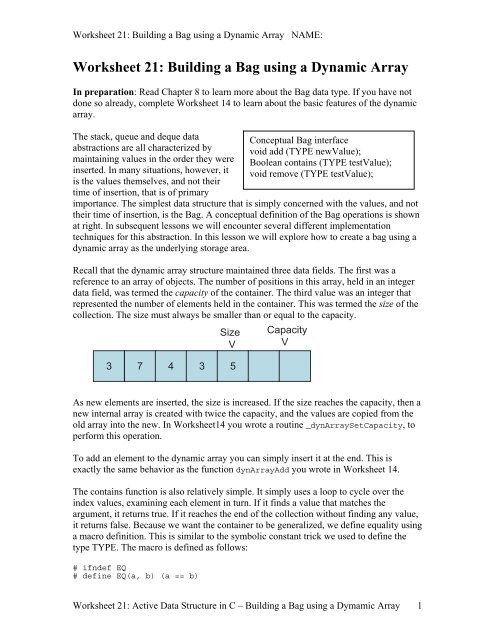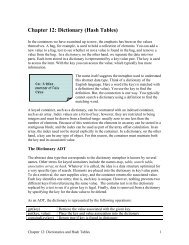Worksheet 21: Building a Bag using a Dynamic Array - Classes
Worksheet 21: Building a Bag using a Dynamic Array - Classes
Worksheet 21: Building a Bag using a Dynamic Array - Classes
You also want an ePaper? Increase the reach of your titles
YUMPU automatically turns print PDFs into web optimized ePapers that Google loves.
<strong>Worksheet</strong> <strong>21</strong>: <strong>Building</strong> a <strong>Bag</strong> <strong>using</strong> a <strong>Dynamic</strong> <strong>Array</strong> NAME:<br />
<strong>Worksheet</strong> <strong>21</strong>: <strong>Building</strong> a <strong>Bag</strong> <strong>using</strong> a <strong>Dynamic</strong> <strong>Array</strong><br />
In preparation: Read Chapter 8 to learn more about the <strong>Bag</strong> data type. If you have not<br />
done so already, complete <strong>Worksheet</strong> 14 to learn about the basic features of the dynamic<br />
array.<br />
The stack, queue and deque data<br />
abstractions are all characterized by<br />
maintaining values in the order they were<br />
inserted. In many situations, however, it<br />
is the values themselves, and not their<br />
time of insertion, that is of primary<br />
importance. The simplest data structure that is simply concerned with the values, and not<br />
their time of insertion, is the <strong>Bag</strong>. A conceptual definition of the <strong>Bag</strong> operations is shown<br />
at right. In subsequent lessons we will encounter several different implementation<br />
techniques for this abstraction. In this lesson we will explore how to create a bag <strong>using</strong> a<br />
dynamic array as the underlying storage area.<br />
Recall that the dynamic array structure maintained three data fields. The first was a<br />
reference to an array of objects. The number of positions in this array, held in an integer<br />
data field, was termed the capacity of the container. The third value was an integer that<br />
represented the number of elements held in the container. This was termed the size of the<br />
collection. The size must always be smaller than or equal to the capacity.<br />
Size<br />
V<br />
3 7 4 3 5<br />
Conceptual <strong>Bag</strong> interface<br />
void add (TYPE newValue);<br />
Boolean contains (TYPE testValue);<br />
void remove (TYPE testValue);<br />
Capacity<br />
V<br />
As new elements are inserted, the size is increased. If the size reaches the capacity, then a<br />
new internal array is created with twice the capacity, and the values are copied from the<br />
old array into the new. In <strong>Worksheet</strong>14 you wrote a routine _dyn<strong>Array</strong>SetCapacity, to<br />
perform this operation.<br />
To add an element to the dynamic array you can simply insert it at the end. This is<br />
exactly the same behavior as the function dyn<strong>Array</strong>Add you wrote in <strong>Worksheet</strong> 14.<br />
The contains function is also relatively simple. It simply uses a loop to cycle over the<br />
index values, examining each element in turn. If it finds a value that matches the<br />
argument, it returns true. If it reaches the end of the collection without finding any value,<br />
it returns false. Because we want the container to be generalized, we define equality <strong>using</strong><br />
a macro definition. This is similar to the symbolic constant trick we used to define the<br />
type TYPE. The macro is defined as follows:<br />
# ifndef EQ<br />
# define EQ(a, b) (a == b)<br />
<strong>Worksheet</strong> <strong>21</strong>: Active Data Structure in C – <strong>Building</strong> a <strong>Bag</strong> <strong>using</strong> a Dymamic <strong>Array</strong> 1
<strong>Worksheet</strong> <strong>21</strong>: <strong>Building</strong> a <strong>Bag</strong> <strong>using</strong> a <strong>Dynamic</strong> <strong>Array</strong> NAME:<br />
# endif<br />
The ifndef preprocessor instruction allows the user to provide an alternative definition for<br />
the EQ function. If none is provided, the primitive equality operator will be used.<br />
The remove function is the most complicated of the <strong>Bag</strong> abstraction. To simplify this task<br />
we will divide it into two distinct steps. The remove function, like the function contains,<br />
will loop over each position, examining the elements in the collection. If it finds one that<br />
matches the desired value, it will invoke a separate function, removeAt (from <strong>Worksheet</strong><br />
14), that removes the value held at a specific location.<br />
void dyn<strong>Array</strong>Remove (struct DynArr * dy, TYPE test) {<br />
int i;<br />
for (i = 0; i < dy->size; i++) {<br />
if (EQ(test, dy->data[i])) { /* found it */<br />
_dyn<strong>Array</strong>RemoveAt(dy, i);<br />
return;<br />
}<br />
}<br />
}<br />
Notice two things about the remove function. First, if no matching element is found, the<br />
loop will terminate and the function return without making any change to the data.<br />
Second, once an element has been found, the function returns. This means that if there<br />
were two or more occurrences of the value that matched the test element, only the first<br />
would be removed.<br />
The removeAt function takes as argument an index position in the array, and removes the<br />
element stored at that location. This is complicated by the fact that when the element is<br />
removed, all values stored at locations with higher index values must be “moved down”.<br />
Once the values are moved down, the count must be decremented to indicate the size of<br />
the collection is decreased.<br />
Based on these ideas, complete the following skeleton implementation of the bag<br />
functions for the dynamic array. You can use any of the functions you have previously<br />
written in earlier lessons.<br />
<strong>Worksheet</strong> <strong>21</strong>: Active Data Structure in C – <strong>Building</strong> a <strong>Bag</strong> <strong>using</strong> a Dymamic <strong>Array</strong> 2
<strong>Worksheet</strong> <strong>21</strong>: <strong>Building</strong> a <strong>Bag</strong> <strong>using</strong> a <strong>Dynamic</strong> <strong>Array</strong> NAME:<br />
struct DynArr {<br />
TYPE * data;<br />
int size;<br />
int capacity;<br />
};<br />
/* the following were written in earlier lessons */<br />
void dyn<strong>Array</strong>Init (struct DynArr * da, int initCap);<br />
void dyn<strong>Array</strong>Add (struct DynArr * da, TYPE e);<br />
/* remove was shown earlier, to use removeAt */<br />
void dyn<strong>Array</strong>Remove (struct DynArr * da, TYPE test) {<br />
int i;<br />
for (i = 0; i < dy->size; i++) {<br />
if (EQ(test, dy->data[i])) { /* found it */<br />
_dyn<strong>Array</strong>RemoveAt(dy, i);<br />
return;<br />
}<br />
}<br />
}<br />
/* you must write the following */<br />
int dyn<strong>Array</strong>Contains (struct DynArr * da, TYPE e) {<br />
}<br />
1. What should the removeAt method do if the index given as argument is not in<br />
range?<br />
2. What is the algorithmic complexity of the method removeAt?<br />
3. Given your answer to the previous question, what is the worst-case complexity of<br />
the method remove?<br />
4. What are the algorithmic complexities of the operations add and contains?<br />
<strong>Worksheet</strong> <strong>21</strong>: Active Data Structure in C – <strong>Building</strong> a <strong>Bag</strong> <strong>using</strong> a Dymamic <strong>Array</strong> 3

















